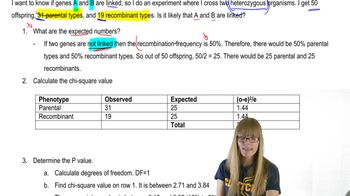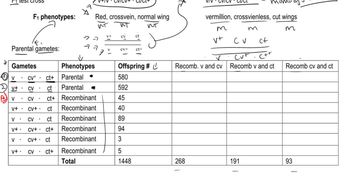Genes A, B, and C are linked on a chromosome and found in the order A–B–C. Genes A and B recombine with a frequency of 8%, and genes B and C recombine at a frequency of 24%. For the cross a⁺b⁺c/abc⁺ × abc/abc, predict the frequency of progeny genotypes. Assume interference is zero.
Table of contents
- 1. Introduction to Genetics51m
- 2. Mendel's Laws of Inheritance3h 37m
- 3. Extensions to Mendelian Inheritance2h 41m
- 4. Genetic Mapping and Linkage2h 28m
- 5. Genetics of Bacteria and Viruses1h 21m
- 6. Chromosomal Variation1h 48m
- 7. DNA and Chromosome Structure56m
- 8. DNA Replication1h 10m
- 9. Mitosis and Meiosis1h 34m
- 10. Transcription1h 0m
- 11. Translation58m
- 12. Gene Regulation in Prokaryotes1h 19m
- 13. Gene Regulation in Eukaryotes44m
- 14. Genetic Control of Development44m
- 15. Genomes and Genomics1h 50m
- 16. Transposable Elements47m
- 17. Mutation, Repair, and Recombination1h 6m
- 18. Molecular Genetic Tools19m
- 19. Cancer Genetics29m
- 20. Quantitative Genetics1h 26m
- 21. Population Genetics50m
- 22. Evolutionary Genetics29m
4. Genetic Mapping and Linkage
Mapping Genes
Problem 9b
Textbook Question
Genes A, B, C, D, and E are linked on a chromosome and occur in the order given.
Previous genetic linkage crosses have determined that recombination frequencies are 6% for genes A and B, 4% for genes B and C, 10% for genes C and D, and 11% for genes D and E. The sum of these frequencies between genes A and E is 31%. Why does the recombination distance between these genes as determined by adding the intervals between adjacent linked genes differ from the distance determined by the test cross?
 Verified step by step guidance
Verified step by step guidance1
Understand the problem: The question asks why the sum of recombination frequencies between adjacent genes (A to E) differs from the recombination frequency determined by the test cross. This involves understanding the concept of genetic linkage and recombination frequencies.
Recall that recombination frequencies are not strictly additive over long distances due to the phenomenon of double crossovers. Double crossovers can occur between genes, and these events are not detected in the recombination frequency, leading to an underestimation of the true genetic distance.
Examine the given recombination frequencies: The recombination frequencies between adjacent genes are 6% (A-B), 4% (B-C), 10% (C-D), and 11% (D-E). Adding these gives a total of 31%, which is the sum of the intervals. However, this does not account for double crossovers.
Understand the test cross result: The test cross measures the overall recombination frequency between genes A and E directly. This value is likely lower than the sum of the intervals because double crossovers between intermediate genes (e.g., B, C, D) are not detected in the test cross, reducing the apparent recombination frequency.
Conclude that the discrepancy arises because the sum of recombination frequencies assumes no double crossovers, while the test cross accounts for the actual recombination events, including the masking effect of double crossovers. This highlights the importance of considering double crossovers when interpreting genetic distances over long regions.
 Verified video answer for a similar problem:
Verified video answer for a similar problem:This video solution was recommended by our tutors as helpful for the problem above
Video duration:
4mPlay a video:
Was this helpful?
Key Concepts
Here are the essential concepts you must grasp in order to answer the question correctly.
Genetic Linkage
Genetic linkage refers to the tendency of genes located close to each other on a chromosome to be inherited together during meiosis. This phenomenon occurs because linked genes are less likely to be separated by recombination events. Understanding linkage is crucial for interpreting recombination frequencies and constructing genetic maps.
Recommended video:
Guided course

Chi Square and Linkage
Recombination Frequency
Recombination frequency is the measure of the likelihood that two genes will be separated during meiosis due to crossing over. It is expressed as a percentage, representing the proportion of offspring that exhibit recombinant phenotypes. This frequency is used to estimate the genetic distance between genes on a chromosome, with higher frequencies indicating greater distances.
Recommended video:
Guided course

Recombination after Single Strand Breaks
Test Cross
A test cross involves breeding an individual with a homozygous recessive organism to determine the genotype of the former. This method helps reveal the presence of linked genes and their recombination frequencies. The results of a test cross can differ from calculated distances due to factors like interference, which can affect the actual occurrence of recombination events.
Recommended video:
Guided course

Trihybrid Cross
Related Videos
Related Practice
Textbook Question
917
views


